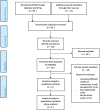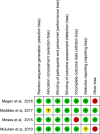Human papillomavirus self-sampling versus standard clinician-sampling for cervical cancer screening in sub-Saharan Africa: a systematic review and meta-analysis of randomized controlled trials
- PMID: 34147103
- PMCID: PMC8214270
- DOI: 10.1186/s13027-021-00380-5
Human papillomavirus self-sampling versus standard clinician-sampling for cervical cancer screening in sub-Saharan Africa: a systematic review and meta-analysis of randomized controlled trials
Abstract
Background: Human papillomavirus (HPV) infection remains a major health threat in sub-Saharan Africa (SSA). HPV self-sampling could help find and treat cervical cancer at an early stage. We aimed to evaluate the effectiveness of HPV self-sampling over the standard health facility-based clinician-sampling for cervical cancer screening through a systematic review and meta-analysis of available randomized controlled trials.
Method: We searched PubMed, Cochrane Central Register of Controlled Trials, ClinicalTrial.gov, and the WHO Global Health Library for articles in SSA published as of 31 May 2020. We followed the Preferred Reporting Items for Systematic Review and Meta-Analysis Protocols (PRISMA-P) 2015 guidelines for the design and reporting of the results. We included randomized control trials that compared HPV self-sampling with the standard of care. The primary endpoint was uptake of cervical cancer screening service. The secondary endpoints were linkage to care, acceptability, screening frequency, and adverse events. We used RevMan V.5.3 software for statistical analysis. We computed random-effect model to provide pooled estimates of available data and I-squared (I2) test to assess heterogeneity.
Result: Of 77 citations, we included four trials from Nigeria, Ethiopia, Kenya, and Uganda, encompassing 8200 participants with age ranging from 25 to 65 years. The pooled analysis showed significantly higher uptake of cervical cancer screening in women who used HPV self-sampling (risk ratio [RR] 1.72, 95% CI 1.58-1.87; p = 0.01), while this had a considerable heterogeneity as explained by subgroup analysis. Uptake was higher in women who were offered sampling kit at home or work (RR 2.05, 95% CI 1.80-2.33) and those who's kit was mailed to or invited to a nearby health center (RR 1.65, 95% CI 1.58-1.72, I2 = 0%) than those screened with the standard of care. There was no difference between the two groups in the rate of linkage to care of positive cases (RR 1.30, 95% CI 0.90-2.74, I2 = 91%). HPV self-sampling was acceptable and easy to use. None of the trials compared the frequency of screening or adverse events.
Conclusion: HPV self-sampling is an effective and feasible alternative to the standard health facility-based clinician-sampling for cervical cancer screening in SSA. It could improve the uptake of cervical cancer screening and harness the global strategy towards elimination of cervical cancer by 2030.
Keywords: Cervical cancer screening; Human papillomavirus (HPV); Randomized controlled trial; Self-sampling; Sub-Saharan Africa; Systematic review and meta-analysis.
Conflict of interest statement
The authors declared that there are no conflicts of interest.
Figures
Similar articles
-
Self-sampling for human papillomavirus (HPV) testing: a systematic review and meta-analysis.BMJ Glob Health. 2019 May 14;4(3):e001351. doi: 10.1136/bmjgh-2018-001351. eCollection 2019. BMJ Glob Health. 2019. PMID: 31179035 Free PMC article.
-
Does self-sampling for human papilloma virus testing have the potential to increase cervical cancer screening? An updated meta-analysis of observational studies and randomized clinical trials.Front Public Health. 2022 Dec 8;10:1003461. doi: 10.3389/fpubh.2022.1003461. eCollection 2022. Front Public Health. 2022. PMID: 36568753 Free PMC article.
-
A systematic review of randomized control trials of HPV self-collection studies among women in sub-Saharan Africa using the RE-AIM framework.Implement Sci Commun. 2021 Dec 15;2(1):138. doi: 10.1186/s43058-021-00243-5. Implement Sci Commun. 2021. PMID: 34911573 Free PMC article. Review.
-
HPV self-sampling versus healthcare provider collection on the effect of cervical cancer screening uptake and costs in LMIC: a systematic review and meta-analysis.Syst Rev. 2023 Jun 22;12(1):103. doi: 10.1186/s13643-023-02252-y. Syst Rev. 2023. PMID: 37349822 Free PMC article.
-
Comparison of two invitation-based methods for human papillomavirus (HPV) self-sampling with usual care among un- and under-screened Māori, Pacific and Asian women: study protocol for a randomised controlled community trial to examine the effect of self-sampling on participation in cervical-cancer screening.BMC Cancer. 2019 Dec 9;19(1):1198. doi: 10.1186/s12885-019-6401-y. BMC Cancer. 2019. PMID: 31815615 Free PMC article.
Cited by
-
Performance of HPV testing, Pap smear and VIA in women attending cervical cancer screening in Kilimanjaro region, Northern Tanzania: a cross-sectional study nested in a cohort.BMJ Open. 2022 Oct 31;12(10):e064321. doi: 10.1136/bmjopen-2022-064321. BMJ Open. 2022. PMID: 36316070 Free PMC article.
-
Human papillomavirus self-sampling versus provider-sampling in low- and middle-income countries: a scoping review of accuracy, acceptability, cost, uptake, and equity.Front Public Health. 2024 Nov 29;12:1439164. doi: 10.3389/fpubh.2024.1439164. eCollection 2024. Front Public Health. 2024. PMID: 39678248 Free PMC article.
-
Acceptability of human papillomavirus self-sampling among women living with HIV in sub-Saharan Africa: A systematic review and meta-analysis.PLOS Glob Public Health. 2025 May 14;5(5):e0004605. doi: 10.1371/journal.pgph.0004605. eCollection 2025. PLOS Glob Public Health. 2025. PMID: 40367209 Free PMC article.
-
Interventions to increase the uptake of cervical cancer screening in low- and middle-income countries: a systematic review and meta-analysis.BMC Womens Health. 2023 Mar 23;23(1):120. doi: 10.1186/s12905-023-02265-8. BMC Womens Health. 2023. PMID: 36959632 Free PMC article.
-
Frequency of cervical premalignant lesions in the gynecologic patients of a tertiary hospital in Mogadishu, Somalia.BMC Womens Health. 2022 Dec 7;22(1):501. doi: 10.1186/s12905-022-02106-0. BMC Womens Health. 2022. PMID: 36476212 Free PMC article.
References
-
- https://www.google.com/search?q=globocan+2018+cervical+cancer. Retrieved May 21, 2020.
-
- Cervical cancer. https://www.who.int/westernpacific/health-topics/cervical-cancer. Retrieved May 21, 2020.
-
- Mboumba Bouassa RS, Prazuck T, Lethu T, Jenabian MA, Meye JF, Bélec L. Cervical cancer in sub-Saharan Africa: a preventable noncommunicable disease. https://pubmed.ncbi.nlm.nih.gov/28440679/. Retrieved May 21, 2020. - PubMed
-
- Projections of mortality and causes of death, 2016 to 2060. 2018. https://www.who.int/healthinfo/global_burden_disease/projections/en/. Retrieved May 21, 2020.
-
- WHO technical guidance and specifications of medical devices for screening and treatment of precancerous lesions in the prevention of cervical cancer. 2020. https://www.who.int/medical_devices/publications/tech_specs_precancerous.... Retrieved May 21, 2020.
Publication types
LinkOut - more resources
Full Text Sources
Research Materials







